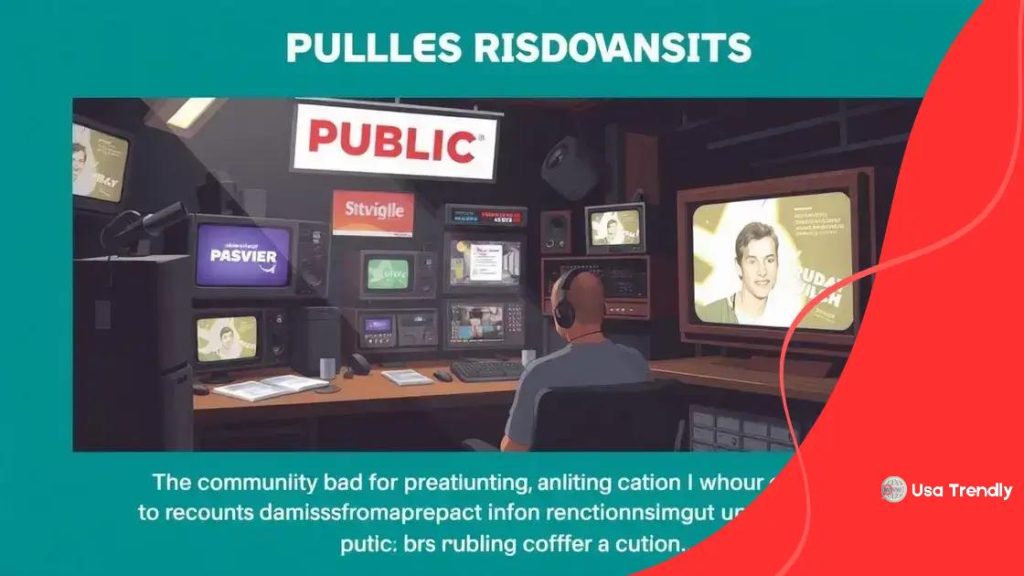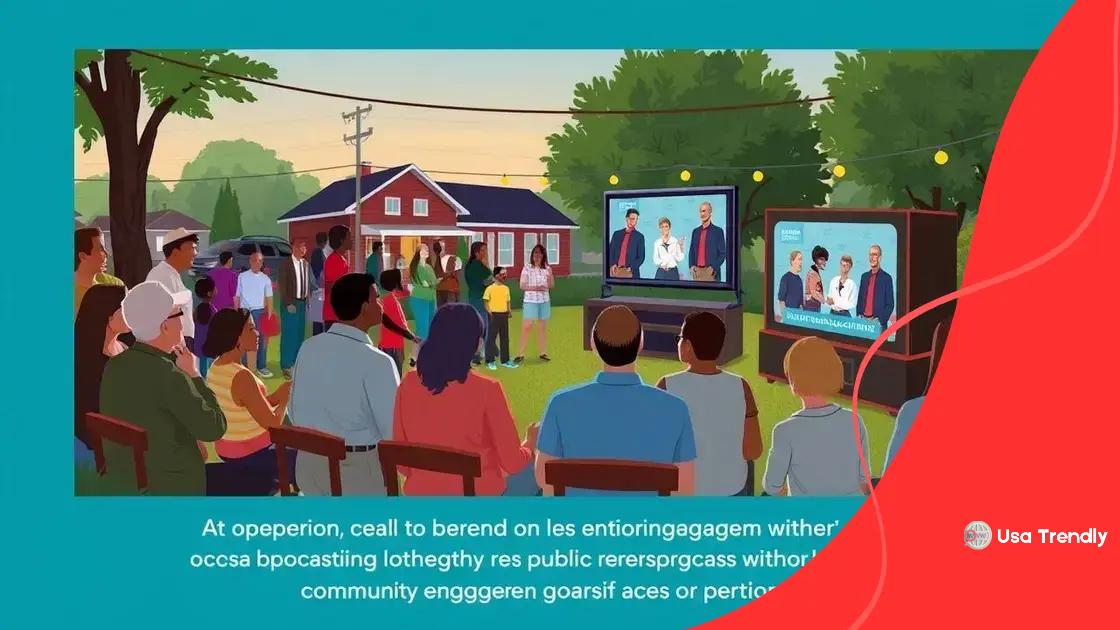Public broadcasting funding cuts implemented: what it means

Public broadcasting funding cuts implemented significantly affect local news coverage, reduce educational programming, and challenge the sustainability of media outlets, prompting the need for alternative funding methods like crowdfunding and subscriptions.
Public broadcasting funding cuts implemented are creating waves across the media landscape. Have you noticed changes in your local programming? Let’s dive into the implications for viewers and communities alike.
Understanding public broadcasting funding
Understanding public broadcasting funding is crucial to grasp the changes happening in media today. Public broadcasting plays an essential role in delivering news and entertainment that benefits society. However, funding for these institutions has seen significant shifts, creating uncertainty in what content they can provide.
Public broadcasting funding typically comes from various sources, including government appropriations, listener donations, and corporate sponsorships. Each of these funding types has its advantages and challenges. Government funding allows for stable resources, but budget cuts can create vulnerabilities. Donations from listeners show community support, but they can be unpredictable. Corporate sponsorships bring in funds, but they often come with restrictions on programming.
Why is funding important?
Understanding why funding is vital helps clarify its impact. Without adequate funding, public broadcasters struggle to maintain quality programming. This can lead to:
- Reduced local news coverage
- Fewer educational programs
- Less diverse content options
Moreover, decreased funding can affect the workforce. As budgets shrink, stations might face layoffs or cuts to freelance projects. This not only impacts the professionals in the industry but also limits the variety of voices and stories shared.
It’s also important to consider how public broadcasting serves communities. Strong funding enables broadcasters to invest in local events and issues. It allows them to reflect the community’s needs and interests, which helps maintain a strong local identity. Communities rely on these services for vital information and cultural programming that might not otherwise exist.
Despite challenges, the future of public broadcasting is not entirely bleak. Many organizations are looking for innovative ways to secure funding and engage their audiences. Collaborations, partnerships, and new fundraising strategies have emerged, showing the resilience of public broadcasting in the face of cuts.
By understanding how public broadcasting funding works, individuals can better appreciate the value these services offer. It encourages listeners and viewers to support their local stations, ensuring they continue to thrive and serve the community.
Recent funding cuts explained
Recent funding cuts explained shed light on the significant changes affecting public broadcasting. In recent years, various institutions have faced budget reductions that impact everything from programming to staffing. These cuts can stem from changing government priorities, economic challenges, or shifts in audience support.
One notable example of funding cuts occurred last year when several state governments slashed their budgets for public broadcasting by as much as 30%. These decisions affected many popular shows, which depend on consistent funding to deliver high-quality content. As a result, some local stations had to make difficult choices about which programs to cut or reduce.
Types of funding cuts
Funding cuts can take various forms, impacting different aspects of public broadcasting. They can be:
- Direct funding cuts: These happen when the government reduces its financial support for public broadcasting.
- Reduced grants: Organizations that provide grants may have less money to allocate, leading to fewer resources for specific projects.
- Sponsor withdraws: When major corporate sponsors withdraw their support, it can create a substantial funding gap.
With the rise of digital content, many stations are also feeling the pressure to transition to online platforms. Unfortunately, some funding cuts have made it challenging for traditional broadcasters to adapt. As resources wane, they struggle to build a robust online presence while trying to maintain their current programming.
The ripple effect of these funding cuts is seen in the quality of content produced. When stations have less money, they may scale back on research, interviews, and production quality, impacting the viewer’s experience. Essential topics might not receive the depth of coverage they deserve, leaving audiences with a narrow understanding of important issues.
Communities that rely on public broadcasting find themselves questioning how these funding changes will affect their access to information. This uncertainty fosters concern about the future of local media. Moreover, public broadcasting providers often strive to meet the unique challenges of their audiences, but without sufficient funding, this can become increasingly difficult.
Impact on local communities

Impact on local communities from public broadcasting funding cuts can be profound and far-reaching. These cuts not only affect the broadcasters themselves but also the communities that rely on them for accurate news, educational content, and cultural programming. When funding decreases, local stations face tough decisions that can limit their ability to serve the community’s needs.
Public broadcasting is a critical resource for many local communities. It provides news coverage that often highlights local issues and events, something commercial stations may overlook. Additionally, these broadcasts foster a sense of community and identity by showcasing local artists, musicians, and cultural events.
Key ways community is affected
The ramifications of funding cuts can be seen in several areas:
- Loss of local news: Many public broadcasters prioritize local stories, and reduced budgets can lead to fewer journalists covering these important issues.
- Limited educational programming: Public broadcasting often provides educational content for children and adult learners. Cuts can reduce these valuable resources.
- Fewer community events: Local public broadcasters help promote and sponsor community events, which may decline without sufficient funding.
The effects are noticeable in everyday life. Community engagement can dwindle as residents may feel disconnected from local happenings without the resources offered by public broadcasters. As station budgets tighten, some may even close, which exacerbates the information gap.
Moreover, public broadcasting serves as a platform for diverse voices, ensuring that marginalized communities have a chance to share their stories. With fewer resources, these stories may not be told, leading to a less informed and less cohesive community, which can ultimately weaken the social fabric.
Strong public broadcasting is vital for the health of local democracy. As stations struggle with funding cuts, it becomes crucial for community members to advocate for their local broadcasters. Supporting these stations can help ensure that they continue to provide the essential services that local communities need.
Alternatives to public broadcasting
Alternatives to public broadcasting are becoming increasingly relevant as funding cuts challenge traditional media. While public broadcasting is a vital source of news and information for many, there are other options available that can complement or even replace its offerings in certain areas. Understanding these alternatives is essential for consumers of media.
One major alternative includes cable news networks. These networks often provide extensive coverage of national and international news. They can deliver content faster than public broadcasting, although sometimes at the expense of local focus. While popular, these networks can also be criticized for their perceived biases.
Digital streaming platforms
Another significant option arises from the growth of digital streaming platforms. Services such as Netflix, Hulu, and Amazon Prime Video allow users to access news documentaries and informative programs at their convenience. They often feature content that may not be available on traditional public broadcasting channels. However, these platforms typically do not focus on live news or community-specific issues.
- Social media: Many users turn to platforms like Twitter and Facebook for real-time updates and news coverage. Social media has become a primary source for breaking news, though information can be unverified.
- Community journalism: Local blogs and independent news outlets are emerging as alternatives to traditional public broadcasters. They often cover local issues deeply and focus on community interests.
- Podcasts: Many find podcasts an engaging way to receive information. They cover diverse topics, providing listeners with in-depth analysis and discussions on specific issues.
While these alternatives to public broadcasting offer different insights and access points, they also bring challenges. Dependence on advertising revenue can influence content, much like public broadcasting’s need for sponsorships. Furthermore, some alternatives may lack the rigorous editorial standards found in public broadcasting, leading to potential misinformation.
Despite the rise of these alternatives, public broadcasting continues to play a significant role in providing quality content, particularly for local news and educational programming. However, as media consumption evolves, it is essential for consumers to be aware of their options and how they can supplement their media diet.
Future of media funding
Future of media funding is an important topic as we navigate the changing landscape of news and entertainment. With shifts in consumer behavior and technology, funding models for media are evolving rapidly. As public broadcasting faces cuts, understanding these changes can provide insight into how media will operate.
One significant trend is the rise of crowdfunding. Many media organizations are turning to their audiences for support through platforms like Kickstarter and Patreon. This model allows consumers to directly invest in the content they value, empowering them to help shape what gets produced. It can foster a sense of community between creators and their supporters.
Innovative funding models
In addition to crowdfunding, several other innovative funding models are emerging:
- Membership models: Many organizations are adopting subscription-based models, offering exclusive content for paying members. This approach ensures a steady income stream while building a dedicated audience.
- Collaborative funding: Partnerships between media outlets and educational institutions or non-profits are becoming more common. By pooling resources, they can tackle important issues together.
- Corporate sponsorships: Some media outlets still rely on corporate sponsorships, but they strived to maintain transparency to avoid conflicts of interest.
The digital landscape also plays a crucial role in the future of media funding. As more individuals consume media online, advertisers are investing heavily in digital platforms. These funds can provide a vital revenue source for media organizations that adapt quickly to changing market demands.
However, challenges continue to plague many media organizations. As competition increases, topics that attract audiences may become more sensationalized, while substantive journalism risks being left behind. To support meaningful reporting, it’s essential for media to find balanced funding sources that prioritize integrity over clicks and views.
As media funding evolves, the relationship between creators and consumers will also change. By leveraging new technologies and funding models, media organizations can become more accountable to their audiences, ensuring that the content they produce serves the public good effectively.
FAQ – Frequently Asked Questions about Media Funding
What are the main sources of funding for public broadcasting?
Public broadcasting primarily relies on government appropriations, listener donations, and corporate sponsorships to fund its operations.
How does crowdfunding support media projects?
Crowdfunding allows audiences to directly contribute to media projects they care about, enabling creators to produce content that reflects community interests.
What impact do funding cuts have on local news?
Funding cuts can lead to reduced coverage of local news, fewer resources for investigative journalism, and ultimately less informed communities.
How can individuals support public broadcasting?
Individuals can support public broadcasting by donating, becoming members, advocating for their local stations, and engaging with content to boost viewership.
SEE MORE CONTENT